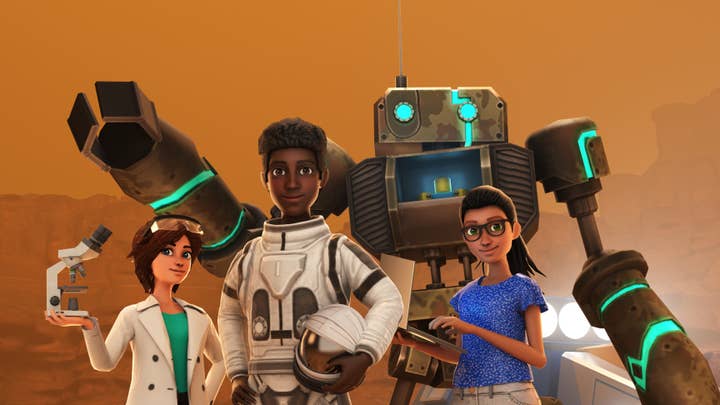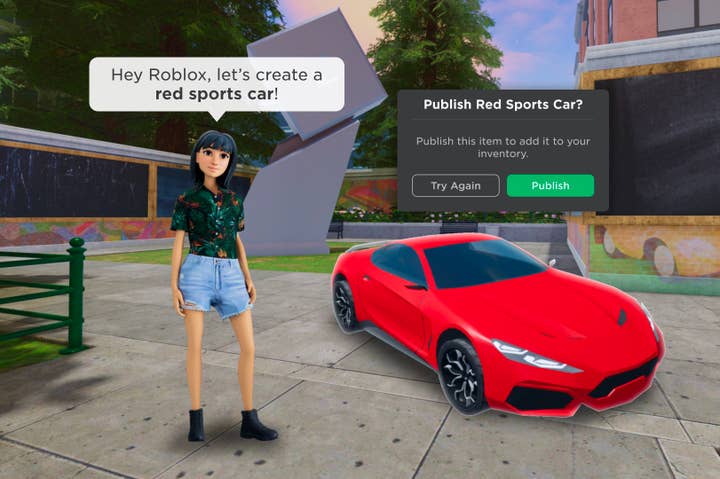Roblox is having its ninth annual Roblox Developers Conference in San Francisco today and tomorrow, and it’s using the event to roll out a few announcements for the gaming platform, including the imminent arrival of Roblox on PlayStation platforms and its full launch on Meta Quest, both of which are happening this month.
Beyond that, the company is also touting Roblox Connect, an “immersive 3D communication experience” for users 13 and over that will use spatial audio and a device’s cameras and microphones to create chat spaces that reflect facial expressions and sound as if in a real-world setting.
The third big announcement of the show is Roblox Assistant, a conversational AI tool intended to assist creators on the platform.
In a pre-show briefing with Roblox chief technology officer Daniel Sturman, it’s the Assistant that draws most of our inquiries.
“It can act as an incredible on-ramp to creators on the platform, but it also can work in a way that can really accelerate existing creators,” Sturman says of the tool. “It’s not a separate thing from Studio. It’s all part of the creator tools we’ve been shipping for years; it’s just accelerating them with the power of generative AI.”
So at a basic level, Sturman says users could ask the Assistant how to import a mesh into Roblox and receive instructions on that process, but it can go further.
“You can say, ‘Hey, I’d like to create a campfire scene,’ and it will pull, for example, trees, a tent, and a fire from our Creator Marketplace and start to place them on a template for you,” Sturman says.
That can then be further tweaked, with Sturman suggesting players could ask it to replace deciduous trees with pine trees, or provide clarification as to the type of tent they’re looking for.
He says the Assistant can also add behavior to objects in the experience as well.
“You can use it to build code behavior, like, ‘I want that experience to have weather. Make it rain 10% of the time,'” Sturman says. “And it will construct the scripts necessary to control the weather with a kind of random rain on some reasonable duration of roughly 10% of the time.”
To do this, Sturman says Roblox is building on open source LLMs and training them as appropriate on its own data based on the Roblox platform.
“Everything we’re doing with generative [AI], we’re using an opt-in model for with creators”
“Everything we’re doing with generative [AI], we’re using an opt-in model for with creators,” Sturman says. “It’s part of the way we think about our relationship with that community.
“And as we roll this out, we’re going to be asking people if they want to contribute their Lua code and their experiences for example to be trained on. And the carrot in that is that if you contribute, you get to use the more advanced, faster version as we build it. You get it sooner.”
He acknowledges some creators won’t want to be included in any AI training data set, and says the company respects that and won’t train its models on their work.
“The same will apply when we get to things like 3D model creation,” Sturman says. “We’re not there yet, but that’s something we’re actively working on. Long term, it’s not just about pulling from the marketplace; it’s about generating new items in 3D for you.”
As an early example of that, Sturman says the company is working on a process to generate in-game avatars based on photos.
Of course, generative AI efforts haven’t always gone as planned. Earlier this year, Roblox said it was hoping to integrate third-party AI creation services into Roblox. Considering the problems Unity had when one of its curated third-party AI tools was discovered to be merely passing off assets it did not have the rights to, we ask how Roblox plans to ensure such third-party tools are operating above board.
“There are some interesting open challenges with using third-party AI tools,” he says. “Wiring them up is not the hard part of launching this. A lot of our experience on moderation will come into play here: understanding the reputation of the creator, vetting what they’re creating, giving creators the ability to flag things when they’re not appropriate… And ‘not appropriate’ could be because of the sort of content they’re doing or in some sense the IP rights of the content they’re creating.
“So all of that framework would have to be built out before you could launch a real third-party AI service. And it’s something we’re still looking at and trying to figure out the best way to approach it.”

There are still other issues with IP when it comes to such generative AI tools, like what happens when a user asks for images of Mickey Mouse or some such property the tools might not have the rights to.
That’s part of the reason we’re looking carefully at what data we train on. First and foremost, you need to make sure it’s appropriate, inclusive, and not driving the type of content or behavior you don’t want to have on the platform. We gotta make sure it’s done in a way that creators openly, willingly give you the rights for this purpose, whether its their assets, their code, or whatever.
He likens the issue to a hand-drawn image of Mickey Mouse and whether that would violate Disney’s rights to the IP.
“That’s what [the US Digital Millenium Copyright Act] is all about, and it’s a process we work very hard on and respect in all of this,” Sturman says. “These answers come from what’s come before – and AI is just a new twist on it – but I think we’re just going to lean on the experience we’ve had to date, which has served us well in this domain, and just build on that.”
Roblox already spends a fair bit on moderation. In the last quarter, it spent almost $1 on “Certain Infrastructure and Trust & Safety” expenses for every $5 of revenue it reported. That was by no means an abnormal quarter, but despite devoting so much to the effort, moderation of content on Roblox remains an unsolved problem.
“AI will open some of what I’ll call ‘new frontiers’ in how we think about safety, but it’s also an incredible tool”
So given the inappropriate content generative AI tools have the potential to put out at scale, does that threaten to overburden a trust and safety team that already requires significant investment and delivers imperfect results?
“AI will open some of what I’ll call ‘new frontiers’ in how we think about safety, but it’s also an incredible tool,” Sturman says, noting that the company is experimenting with real-time voice moderation at scale, such that AI can flag offenses in real time and escalate issues to human monitors.
“Of course AI brings some unique challenges to how you do moderation, but it’s also bringing some incredible opportunities to how you make moderation better and stronger.”
There’s also the question of devaluing content. As much as lowering the barriers to development is a good thing, we have seen repeatedly in the past that it often goes hand-in-hand with widespread price erosion. Even as mobile games evolved in complexity and depth of gameplay, they raced went from price points near $10 to $1 and then finally to free-to-play. Steam and consoles marketplaces have greatly opened up to developers in the past decade, but they’ve also seen developers resort frequently to deep discounts as the best way to surface in discoverability systems regularly abused by bad actors.
Given Roblox is driven by a creator economy, how does it plan to prevent the introduction of AI-generated content from undermining existing creators’ ability to command prices that make their work worthwhile?

“What we’ve seen over the course of technology in general is a move away from the need to do things by brute force, and instead increasingly what will determine what a successful creator is will be that spark of genius they have on the idea or concept of what they want to go do,” Sturman says. “And we see that on Roblox already as being what separates a successful experience from a less successful experience, and we think that will just accelerate it.”
“No one has an interest in a race-to-the-bottom sort of economy… That tends to discourage creation when you have that.”
He adds, “No one has an interest in a race-to-the-bottom sort of economy. That would not be what I would call a healthy economy, whether it was on Roblox or in the real world. That tends to discourage creation when you have that.
“I feel we have some really good systems in place, and economic research is something we continue to invest in and spend a lot of time on as well. I think as long as we build the right economic systems, it will come down to having the good idea versus the manual labor of building the item. I think it should really be more the great idea that drives this.”
We point out that gaming in particular has a rich tradition of great ideas that were stolen by people who went on to produce a knock off, and in some cases a knock off more successful than the genuine article. Sturman says the company has tools in place to address these concerns.
“On Roblox when you build a Limited, there’s a manufacturing fee associated with it, which really is an economic tool to ensure you have skin in the game when you’re building an item and that there isn’t a race to the bottom on all of this,” Sturman responds.
“Over time, that fee will probably do things like move based on the actual market conditions of how much demand there is for something in the marketplace. There are a number of economic tools we can use to ensure we’re not in a mode where creation is just free and if I can sell it for .1 Robux or whatever, that just makes any sense at all. You want creators to be involved in the process and to feel they’re going to have viable effort lead to viable reward in the entire piece.”
Other announcements from RDC include the introduction of new tools that will let developers create subscriptions within their games and experiences, and an update to the Creator Marketplace that will see creators keep 100% of their sales (minus taxes and processing fees). On top of that, purchases on the Creator Marketplace will be made in US dollars instead of Robux.
When we ask if Roblox will move other parts of the platform away from its virtual currency, Sturman says there are no such plans.
“There are a lot of reasons why having a virtual currency is working well for us,” he says.